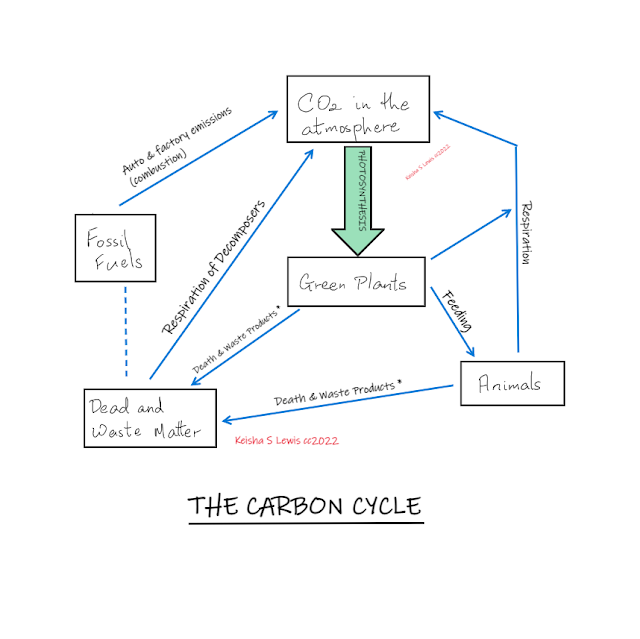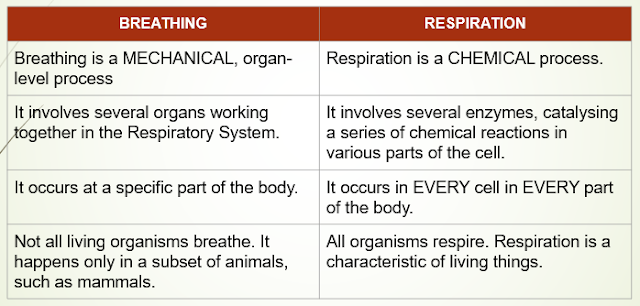THE NUTRIENT CYCLES [CSEC BIOLOGY & HSB]
SYLLABUS REFERENCE
HSB
[A14] describe the recycling of carbon and nitrogen in nature.
CSEC BIOLOGY
[A5.1] explain, with examples, the impact of the continual re-use of materials in nature;
WHAT IS A NUTRIENT CYCLE?
This refers to the recycling of important elements through the living and physical world, in the forms of various chemical compounds.
This is how matter is cycled through the planet's systems.
The movement of energy is opposite. It is a one-way trip, from the Sun to living organisms, and eventually lost as heat.
THE CARBON CYCLE
The cycle consists of the following stages:Carbon Fixation
This is how carbon is transferred from the atmosphere to the living world, via the Producers.
The process involved is Photosynthesis.
During photosynthesis, light energy is used to convert simple, inorganic carbon dioxide to complex organic compounds, starting with glucose.
Carbon's Return to the Atmosphere
This is how carbon is transferred from living material, back to the atmosphere.
This happens via respiration, decay, & combustion.
- Respiration and Combustion
- The waste product of respiration is carbon dioxide. This gas then is released back into the atmosphere.
- When carbon-based fuel is burnt, carbon dioxide is one of the main products.
- Fossil fuels are also burnt, producing high levels of carbon dioxide. This combustion occurs via industry and the internal combustion engines of motor vehicles.
- Death and Decay
- Carbon enters the soil via the death of producers and consumers, as well as release of waste products such as shed leaves, urine, and faeces.
- Various decomposers (bacteria and fungi) break down the bodies of dead organisms, as well as their waste matter. Respiration of the decomposers converts the complex organic compounds to carbon dioxide. This gas is thus returned to the atmosphere.
Disruption of the Carbon Cycle
Fossil fuels are millions of years of accumulated carbon.
They have been extracted from the ground and are now combusted in mostly factories and cars with internal combustion engines.
Carbon dioxide is one of the gases produced, which is thus released into the atmosphere at rapid rates.
The following video explains how the consequences of this disruption, in terms of climate change and its effects.
THE NITROGEN CYCLE
Nitrogen Fixation
This refers to the conversion of the unreactive nitrogen gas in the atmosphere to the reactive nitrate compounds.
This makes nitrogen available to plants, which then use it to manufacture proteins and other nitrogenous (nitrogen-based) compounds.
Nitrogen fixation can occur in the following ways:
- Lightning Strike - The air in the vicinity of the strike gets ionised. The nitrogen then reacts with the oxygen in the atmosphere to produce nitrates.
- Bacterial Action - Nitrogen-fixing bacteria can be found either in the soil or in root nodules of legumes (pigeon peas for example). These bacteria convert nitrogen gas to nitrates.
Nitrogen in Living Organisms
Nitrogen enters the living world via plants as they obtain nitrates from the soil. This process is called assimilation.
Nitrogen then passes through the living world via feeding, death & excretion, and decomposition.
- Assimilation - Plants absorb nitrates from the soil, which it can then use to manufacture protein and other nitrogenous compounds, such as DNA.
- Feeding - Consumers eat plants and other consumers. Most of the nitrogen is found in plant and animal protein.
- Death & Excretion - When plants and animals die, their bodies become part of the soil and thus available to decomposers (bacteria & fungi). Waster products, such as shed leaves, urine and faeces, also join the soil. They also become available to decomposers.
- Decomposition - Decomposers convert the decaying matter to ammonium ions, which then undergoes nitrification.
- Some of the nitrogen-fixing bacteria in the soil can only convert nitrogen gas from the atmosphere to ammonium. This process is called Ammonification.
- Ammonium, which is a very soluble, reactive compound, is converted to nitrites, then nitrates via the action of nitrifying bacteria. This process is called Nitrification.
Nitrogen is returned to the atmosphere via the conversion of nitrates to nitrogen gas.
Denitrifying bacteria in the soil carry out this process.




